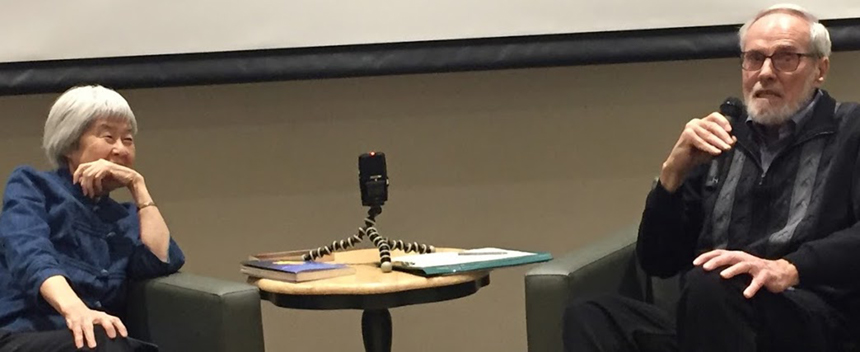
What would bring 200 people out on a windy, grey afternoon last November to the Southern Alberta Ethnic Association Centre for the fall conference of the Mennonite Historical Society of Alberta?
While most of the audience—a mixture of local Japanese and Mennonite community members, Mennonite history enthusiasts and lovers of Canadian literature—were attracted by the guest speakers, authors Joy Kogawa and Rudy Wiebe, the event itself proved to illustrate the theme, “Tapestry of uprooted cultures,” before the first address was even made.
As one attendee observed, the Coaldale area was unique among many rural Mennonite centres, in that it was far from homogenous. Wiebe estimated that when he and Kogawa were schoolmates there in the early 1950s, a third of the students were Mennonite, another third were Japanese, and the remainder were either “English” or Mormons. Rather than creating segregation and division in the community, relationships of mutual respect, admiration and friendship developed.
David Tanaka, president of the Nikkei Cultural Society, which co-hosted the event, gave a brief history of Japanese migration to the area. Like Mennonites, the Japanese arrived in distinct waves. The first group, working primarily in coal mines and for area farmers, arrived in the late 1800s and early 1900s. The second and best known group were the interns—Japanese people who had been living on Canada’s West Coast who were forcibly relocated to the Prairies at the start of the Second World War; 2,500 settled in southern Alberta, including Kogawa’s family. A final group of primarily university students arrived in the 1960s, when Canada opened immigration to Japan and Asia.
Katie Harder, a historical society board member, introduced Kogawa and Wiebe, noting that the imagined living of history can sometimes be “more truthful” than formal histories, which include only that which can be footnoted.
Although Kogawa’s and Wiebe’s families arrived in southern Alberta under very different circumstances—one due to forced exile and the other as a voluntary escape—both identified the resulting internal struggle with self-identity as the central focus of their early writing.

For Kogawa, being from the fundamentally different mindset of an eastern culture living in a western world, as well as being visibly distinguishable as Asian, gave rise to a deep crisis of self-identity and a desperate desire to be anything but Japanese-Canadian. This was reinforced when her first and best known novel, Obasan, a veiled telling of her own family’s story of internment, was initially refused publication. Publishers did not expect anyone would want to read it. Writing, however, remained therapeutic for her, and with her later novel, The Rain Ascends, she was finally able to shed her feelings of alienation.
For Wiebe, the difficulties faced by Mennonites during the Second World War were due to their beliefs and refusal to fight rather than due to their racial identification. In this context, his first book, Peace Shall Destroy Many, was an exploration of identity problems internal to the Mennonite community—how to respond to war—rather than the challenges of fitting into the larger community. While he had no trouble getting it published, he faced the threat of expulsion from his own community for having exposed these struggles.
Looking beyond these earlier novels, both Wiebe and Kogawa discussed how they, as writers, also confront the ills and needs of society at large.
“Writing helps to awaken consciousness,” said Wiebe. “We need to know our stories, to understand them.” As a writer, he has been committed to telling the whole story, “both the beautiful and the lurid.”
Kogawa also spoke of her commitment to truth-telling through her writing. For her, writing is both an art and a cure for humanity. In addressing the woundedness in society, she spoke of the need for mercy, not only justice: “We no longer have time to deal with justice first,” she said. “We are desperate for reconciliation. Mercy will lead us there.”
The conversation throughout the afternoon returned again and again to the gift that the community of Coaldale had been.
Wiebe recalled a particularly influential teacher, Mr. Robinson, who modelled inclusion and under whose influence bullying disappeared. He noted that his years in Coaldale were crucial in allowing him to continue his education, which set him on his life’s path.
Kogawa credited her passion for truth-telling and honesty to her Mennonite friends and neighbours who modelled it faithfully under challenging circumstances. Her family noticed a marked difference between this community-minded approach and their previous experience of big city life in Vancouver.
A longer version originally appeared in the Mennonite Historical Society of Alberta newsletter.
Watch a drumming performance online at bit.ly/mhsa-drumming.

Add new comment
Canadian Mennonite invites comments and encourages constructive discussion about our content. Actual full names (first and last) are required. Comments are moderated and may be edited. They will not appear online until approved and will be posted during business hours. Some comments may be reproduced in print.